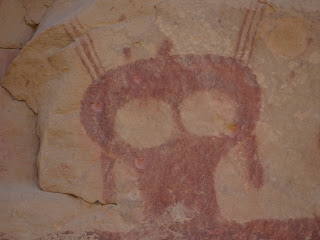Monday, August 6, 2012
July 26: The Ancients Were Here
Before we left Moab, we had one more local destination that we knew would be sensational, since we visited it last summer.
At the south end of the “Book Cliffs,” about 50 miles north of Moab, in a truly desolate area of the country, lies Sego Canyon. It is reachable by means of a dusty gravel road.
The mouth of the canyon forms an almost perfect circular amphitheater, perfect for ancient ceremonies and sacred rites.
And here are located four separate panels of rock art, facing south and east. Thus we were sure to get there in the morning. We remained there 5-6 hours, despite the heat.
The images spanned centuries, revealing how many separate groups of canyon peoples have used this place as a sacred gathering site. The most astonishing images are pictographs from the Barrier Canyon culture, anywhere from 2,000 to 4,000 or more years ago. But there are also petroglyphs from the Anasazi cultures, the Fremont culture, and the more recent Ute Indians.
Once again, the panels are in theatrical display setting. Two of the four panels are on facing walls of a promontory that would make an excellent location for ceremonial leaders to be seen and heard.
One of the Barrier Canyon panels is in excellent condition, for the most part.
Some bullet holes mar the figures. These are the “goggle-eyed” spirits, as I call them.
The images are dominated by strange, elongated anthropomorphs
surrounded by magical geometric shapes and creatures
(like the horned snake, reminiscent of prehistoric Meso-American cultures).
Shamans or rock spirits?
Or spirit beings?
One looks like a ghost and is very similar to the great figure in the “Holy Ghost” panel in Horseshoe Canyon, Canyonlands National Park.
No one image is like any other. All have diverse costuming. Most have no appendages; and those that do have weird, stringy arms. We will see this many times, in terms of Barrier Canyon images.
The second Barrier Canyon panel is at ground level and has been treated poorly. It is located in an area that is still used as a cattle round-up location for cattle ranchers in Sego and Thompson Canyons. Note the loading stall.
Those are cattle memorials left at the foot of the ancient, priceless pictographs.
A truck tire was left within twenty feet.
As recently as this spring, local teenagers left marks of their undying love on the rock surfaces surrounding the pictographs.
Bullet holes riddled the panel.
Most of the land here is private, and the BLM is doing what it can to keep the area open to visitors. In fact, there were cars from Texas, California, and Wyoming in the parking lot while we visited.
A good omen, I think, that not everyone is a Neanderthal. (Actually, Neanderthals may have produced similarly awesome cave art.)
Again, the images display a wide variety. Some of the anthropomorphs are so abstract as to be geometric.
These triangular-shaped bodies, from over the ancient era look remarkably like Fremont figurines and images from around 1200 A.D. The Fremont were a totally different culture. Yet, one of the other four rock art panels clearly represents Fremont petroglyphs (not pictographs) that show possible influence of Barrier Canyon concepts.
So much for the assumption that cultures are isolated.
The panels are also marked by petroglyphs from Anazasi cultures.
And the last panel shows a mixture of Anasazi
and Ute images, many of which still show evidence of the fact that the petroglyphs were originally “painted”!
This must have been a sacred site to the ancients. We even noticed that there are Native Americans today who regard it as a sacred site still. The rule is to leave nothing behind when visiting the “outdoor museum.” But who will object to what some Indian left behind on a shrub in front of the Barrier Canyon spirits?
Subscribe to:
Post Comments (Atom)

























No comments:
Post a Comment